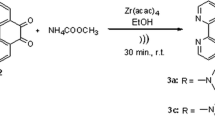Summary
This paper describes use of a novel substituted melanin which is useful in detection of differentiating leukemia cells and their membranes. Comparisons of luminol-(5-amino-2,3-dihydro-1,4-phthalazinedione) and diazoluminomelanin (DALM)-mediated chemiluminescence (CL) were made with various types of differentiated and undifferentiated HL-60 whole cells, cell lysates, and membrane fractions. Luminol had a greater CL response than DALM with HL-60 promyelocytic stem cells and differentiated macrophage-like or neutrophil-like whole cell and cell lysate preparations. However, DALM showed markedly greater CL than luminol for membrane fractions derived from each cell type. The greatest luminol-dependent CL was observed for cell types high in myeloperoxidase (MPO). The greatest DALM-mediated CL was seen with cell types that are high in MPO or strong producers of superoxide (O2-) anions. In some cases, significant differences in CL could also be distinguished on the basis of inducing agent used [i.e. dimethylsulfoxide, all-trans retinoic acid or 12-o-tetradecanoylphorbol-13-acetate]. Both luminol- and DALM-dependent CL were strongly inhibited by preincubation of cellular preparations with 3-amino-l-tyrosine (a component of DALM). Taken together, these data suggest that the reaction mechanism of luminol favors interaction with cytoplasmic MPO whereas that of DALM favors membrane interactions. Thus, both reagents may be of use in assays to detect differentiating leukocytes or their cellular components.
Similar content being viewed by others
References
Dahlgren, C.; Stendahl, P. Role of myeloperoxidase in luminol-dependent chemiluminescence of polymorphonuclear leukocytes. Infect. Immunol. 39:736–741; 1983.
DeChatelet, L. R.; Long, G. D.; Shirley, P. S., et al. Mechanism of luminol-dependent chemiluminescence of human neutrophils. J. Immunol. 129:1589–1593; 1982.
Dods, R. F.; Essner, E.; Barclay, M. Isolation and characterization of plasma membranes from anl-asparaginase-sensitive strain of leukemia cells. Biochem. Biophys. Res. Comm. 46:1074–1081; 1972.
Fibach, E.; Peled, T.; Treves, A., et al. Modulation of the maturation of human leukemic promyelocytes (HL-60) to granulocytes or macrophages. Leukemia Res. 6:781–790; 1982.
Gallagher, R.; Collins, S.; Trujillo, J., et al. Characterization of the continuous differentiating cell line (HL-60) from a patient with acute promyelocytic leukemia. Blood 54:713–733; 1979.
Harris, P.; Ralph, P. Human leukemic models of myelomonocytic development: a review of the HL-60 and U937 cell lines. J. Leukocyte Biol. 37:407–422; 1985.
Kiel, J. L.; O’Brien, G. J.; Dillon, J., et al. Diazoluminomelanin a synthetic luminescent biopolymer. Free Rad. Res. Comm. 8:115–121; 1990.
Kiel, J. L.; O’Brien, G. J.; Simmons, D. M., et al. Diazoluminomelanin: a synthetic electron and nonradiative transfer biopolymer. In: Allen, M. J.; Cleary, S. F.; Hawkridge, F. M., eds. Charge and field effects in biosystems, volume 2. New York: Plenum Press; 1989:293–300.
Lefkowitz, D. L.; Lefkowitz, S. S.; Mone, J., et al. Peroxidase-induced enhancement of chemiluminescence by murine peritoneal macrophages. Life Sci. 43:739–745; 1988.
Levy, R.; Rotrosen, D.; Nagauker, O., et al. Induction of the respiratory burst in HL-60 cells: correlation of function and protein expression. J. Immunol. 145:2501–2595; 1990.
Matzner, Y.; Gavison, R.; Rachmilewitz, E. A., et al. Expression of granulocytic functions by leukemic promyelocytic HL-60 cells: differential induction by dimethylsulfoxide and retinoic acid. Cell Differ. 21:261–269; 1987.
Newburger, P. E.; Chovaniec, M. E.; Greenberger, J. S., et al. Functional changes in human leukemic cell line HL-60: a model for myeloid differentiation. J. Cell Biol. 82:315–322; 1979.
Ross, D. Measurement of myeloid maturation by flow cytochemistry in HL-60 leukemia: esterase is inducible, myeloperoxidase is not. Cytometry 7:263–267; 1986.
Rovera, G.; Santoli, D.; Damsky, C. Human promyelocytic leukemia cells differentiate into macrophage-like cells when treated with phorbol diester. Proc. Natl. Acad. Sci. USA 76:2779–2783; 1979.
Stendahl, O.; Dahlgren, C.; Hed, J. Physicochemical and functional changes in human leukemic cell line HL-60. J. Cell Physiol. 112:217–221; 1982.
Yen, A.; Forbes, M.; DeGala, G., et al. Control of HL-60 cell differentiation lineage specificity, a late event occurring after precommitment. Cancer Res. 47:129–134; 1987.
Yen, A.; Freeman, L.; Fishbaugh, J. Induction of HL-60 monocytic cell differentiation promoted by perturbation of DNA synthesis: hydroxyurea promotes the action of TPA. Exp. Cell Res. 174:98–106; 1988.
Zinzar, S.; Ohnuma, T.; Holland, J. F. Effects of simultaneous and sequential exposure to granulocytic and monocytic inducers on the choice of differentiation pathway in HL-60 promyelocytic leukemia cells. Leukemia Res. 13:23–30; 1989.
Author information
Authors and Affiliations
Rights and permissions
About this article
Cite this article
Bruno, J.G., Kiel, J.L. Luminol and diazoluminomelanin as indicators of HL-60 cell differentiation. In Vitro Cell Dev Biol - Animal 29, 737–741 (1993). https://doi.org/10.1007/BF02631430
Received:
Accepted:
Issue Date:
DOI: https://doi.org/10.1007/BF02631430



